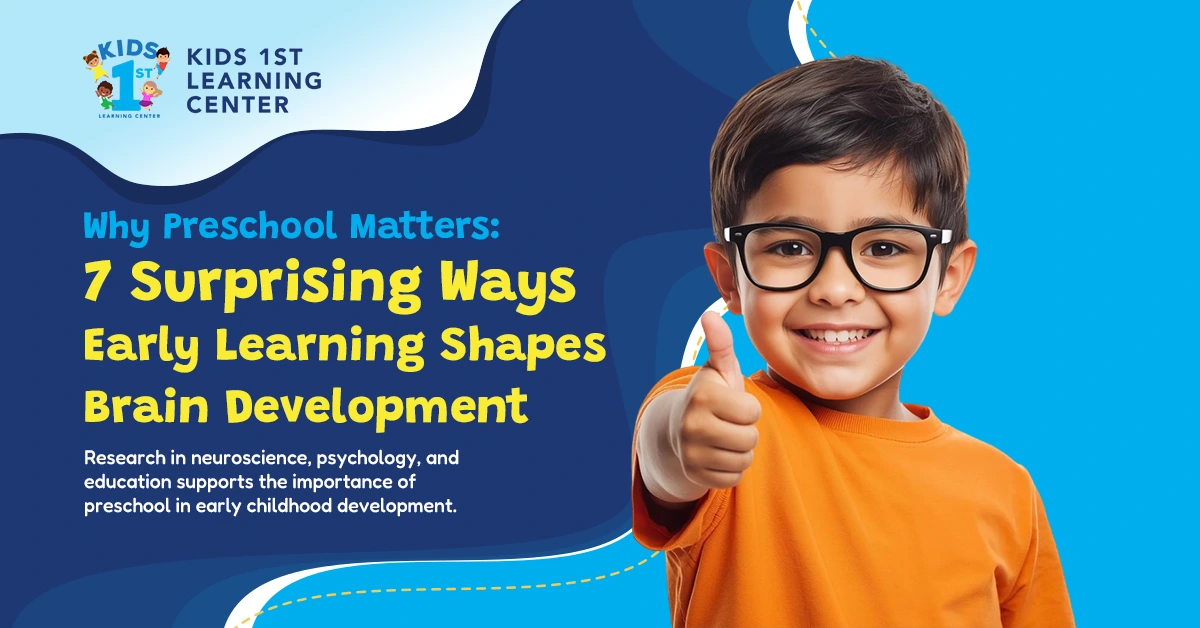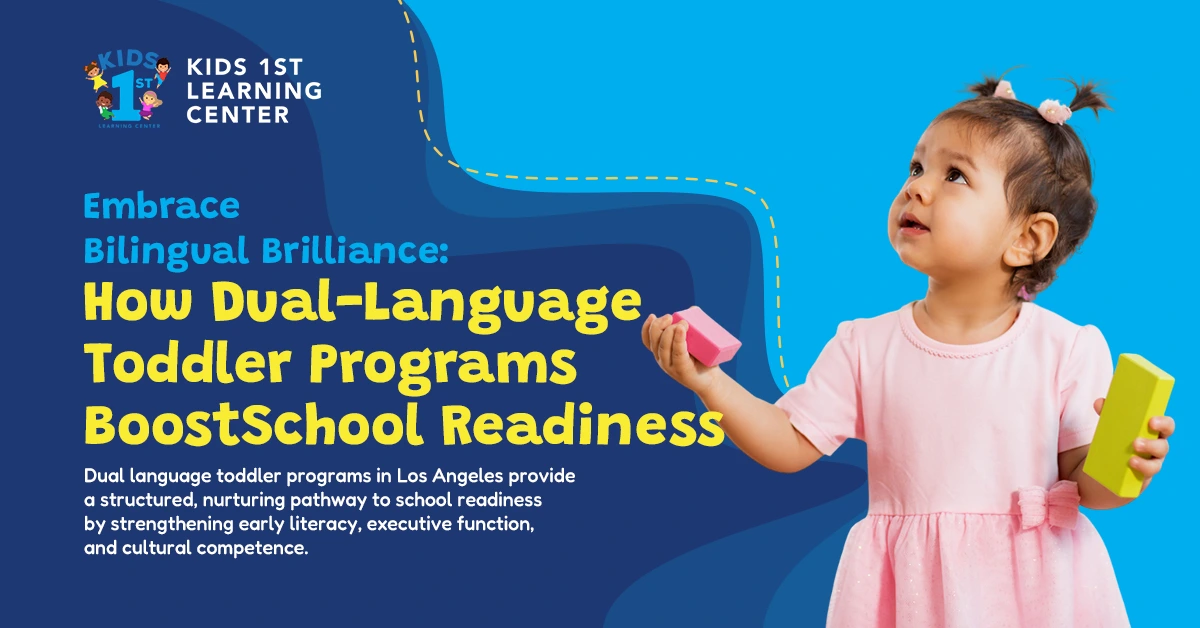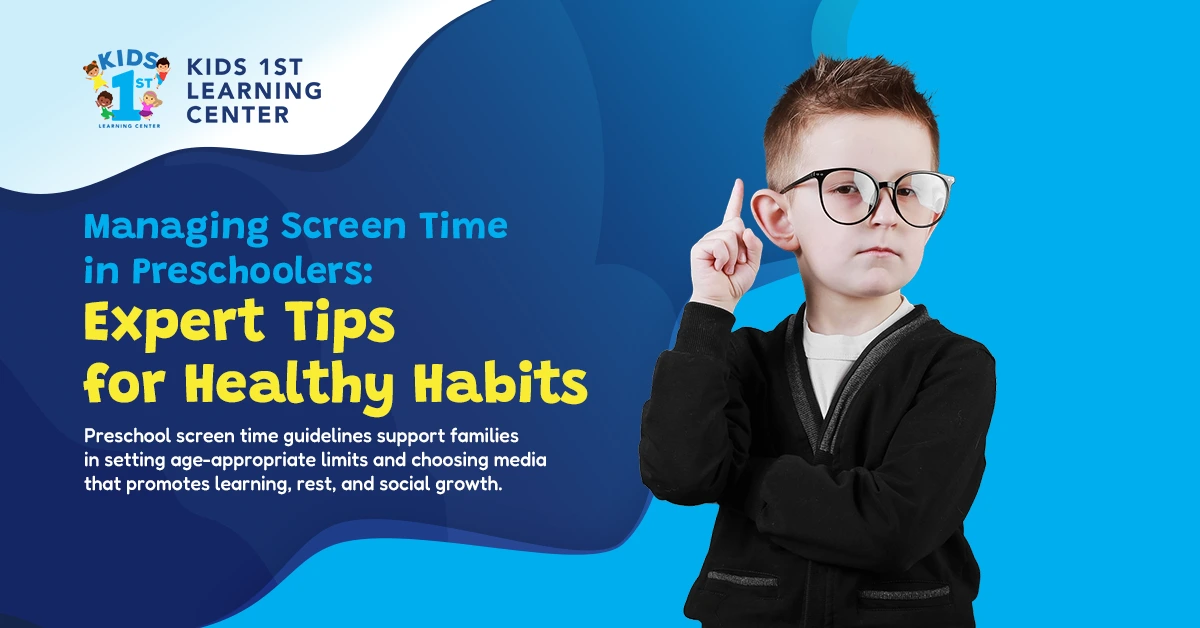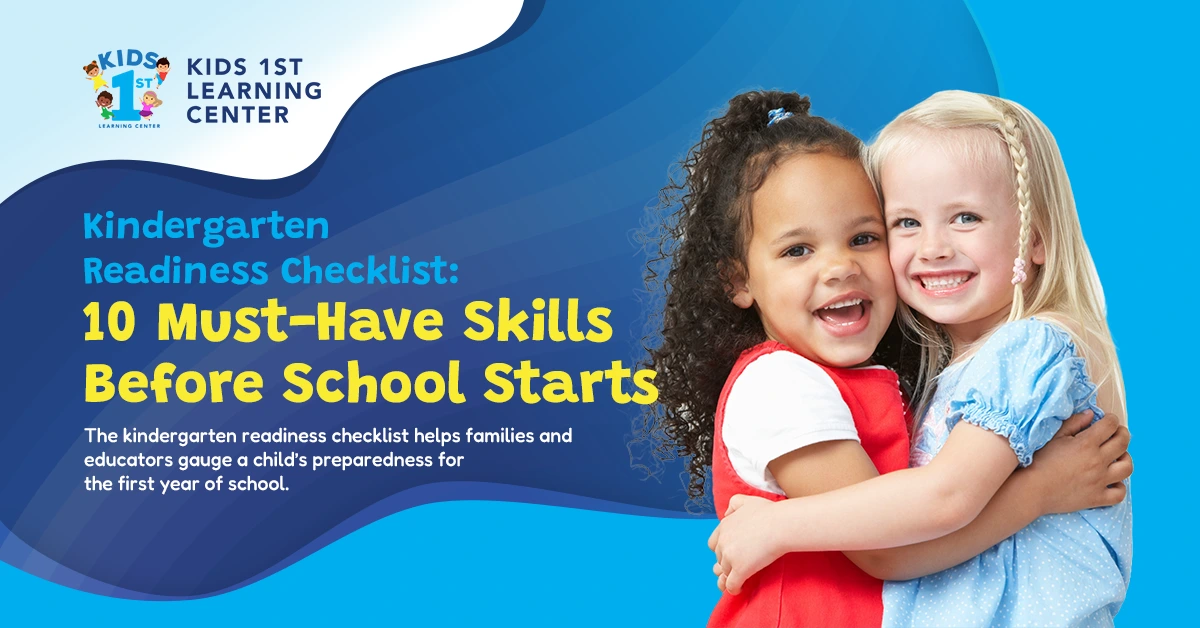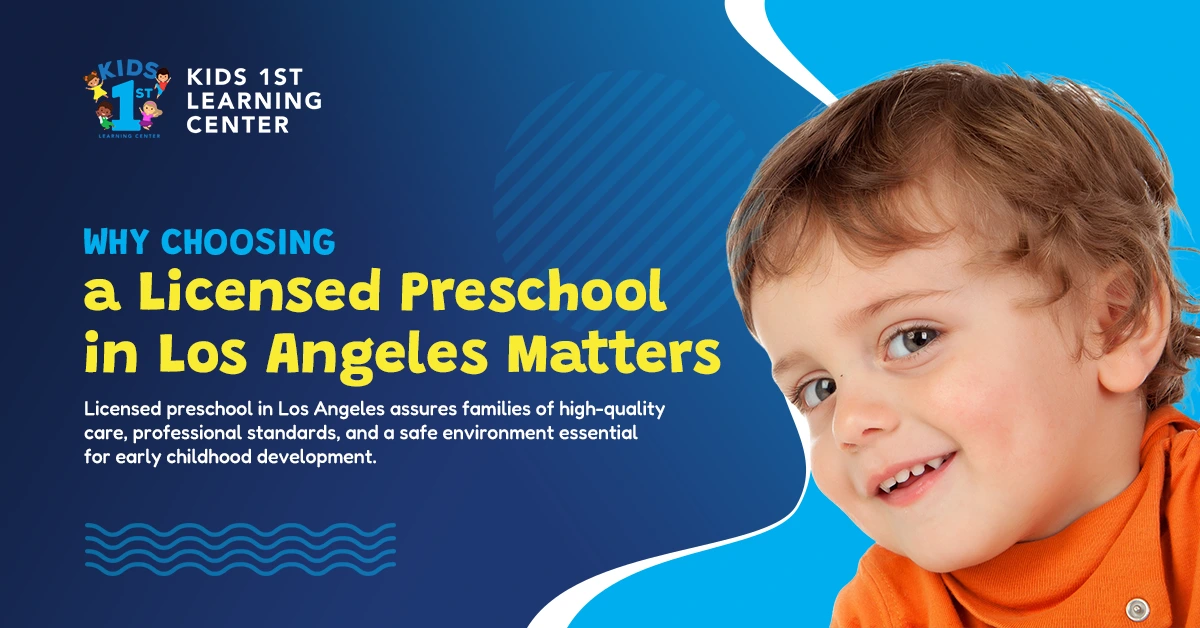The kindergarten readiness checklist helps families and educators gauge a child’s preparedness for the first year of school. It brings structure to what can feel uncertain by translating development into clear, observable behaviors across daily routines and early learning experiences. The emphasis is on growth, not perfection, recognizing that children develop at individual paces and benefit from consistent guidance, practice, and encouragement.
This introduction explains what to look for, how to document progress, and when to provide extra support so each child arrives confident, curious, and ready to participate. Use it as a practical tool to align home and preschool efforts for a smooth transition.
1. Kindergarten Prep Skills: Social–Emotional Readiness
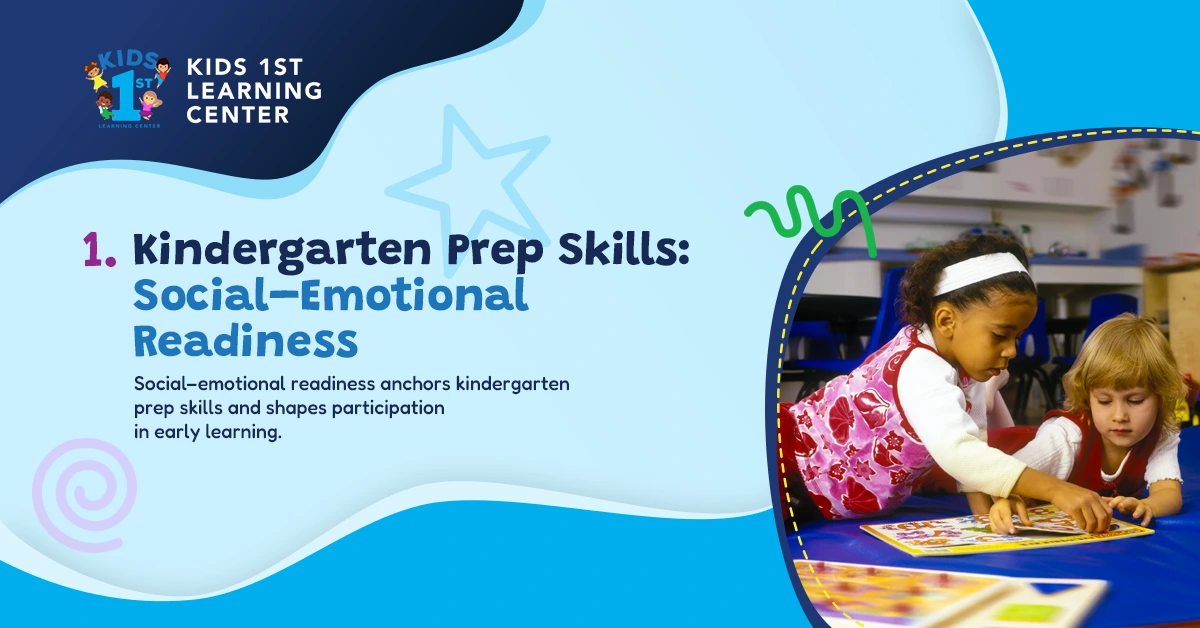
Social–emotional readiness anchors kindergarten prep skills and shapes participation in early learning. It includes recognizing and naming feelings, recovering from frustration, cooperating with peers, and communicating needs with words or agreed-upon cues. Daily practice at home and school strengthens these behaviors and builds confidence.
- Emotion vocabulary: Label feelings during routines and stories to connect words with body cues.
- Calm-down routine: Practice breathing, counting, or a brief movement break before challenges arise.
- Cooperative play: Model sharing, turn-taking, and simple planning during games and center time.
- Help-seeking: Teach a short script or signal to request assistance instead of acting out.
- Flexibility: Rehearse small schedule changes and use visuals to preview what happens next.
Keep brief notes on triggers, strategies used, and recovery time to monitor progress, then review them weekly. Share a concise summary with teachers so that home and school reinforce the same supports. Adjust routines, visuals, and practice opportunities to ensure consistent, practical help is in place before kindergarten begins.
2. School Readiness Activities for Listening, Direction-Following, and Focus
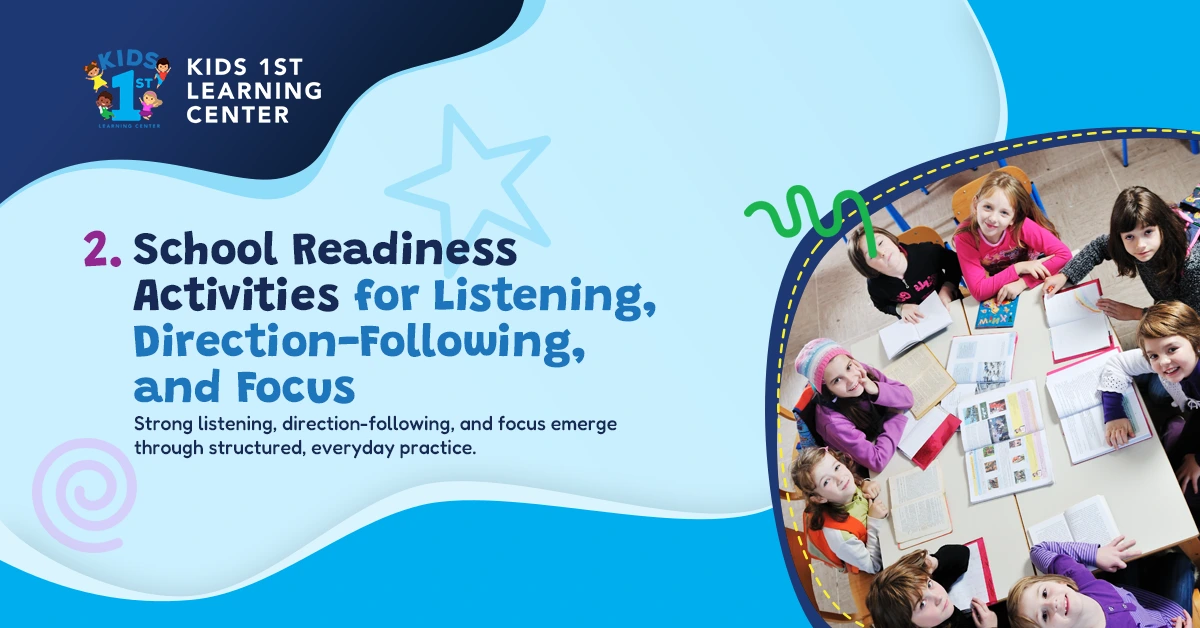
Strong listening, direction-following, and focus emerge through structured, everyday practice. School readiness activities should be short, predictable, and embedded in routines so children know what to expect and how to participate. Consistency across home and preschool helps skills transfer into group learning.
- Active listening cues: Teach “eyes, ears, body still” and model the posture before group time.
- One-step directions: Start simple, give processing time, and add a second step when ready.
- Visual prompts: Use picture cards, timers, and first–then boards to preview tasks and transitions.
- Brief work bursts: Practice 5–7 minute activities, then a movement break to reset attention.
- Cleanup routines: Sing a short cue, sort materials together, and praise specific follow-through.
Track progress by noting how many prompts are needed and how long attention is sustained. Share updates weekly so adults can match language, cues, and expectations; aligned practice builds stamina and helps children participate calmly and confidently in kindergarten settings.
3. Preschool to Kindergarten Transition: Family–Teacher Coordination and Routine Preview
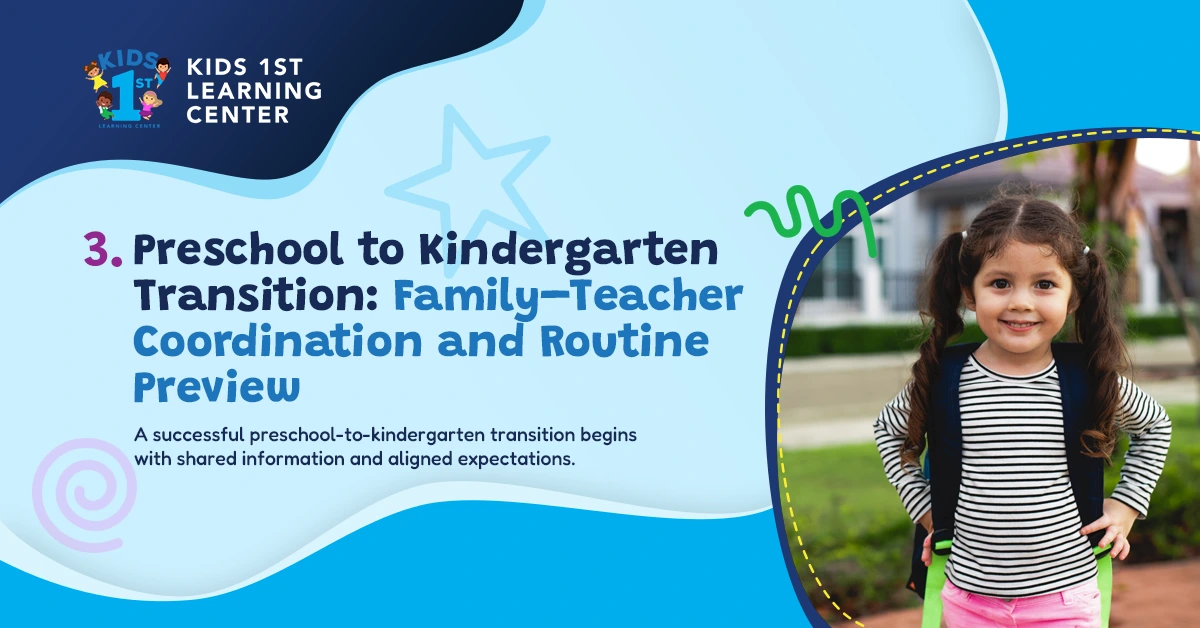
A successful preschool-to-kindergarten transition begins with shared information and aligned expectations. Families and educators can reduce anxiety by previewing new spaces, rehearsing daily routines, and agreeing on consistent language for directions and support. The goal is continuity, so children recognize what to do from the first day.
- Share records: Provide summaries of strengths, goals, and effective strategies from preschool.
- Plan orientation: Attend visit days, meet the teacher, and practice entry routines such as lining up and cubby use.
- Preview routines: Use photos of the classroom and a simple schedule at home to show what happens next.
- Align supports: Confirm how calm-down tools, visuals, and support plans will continue in kindergarten.
- Build independence: Practice zipping, bathroom routines, opening lunch items, and carrying a folder or backpack.
Begin these steps six to eight weeks before school, keeping a small transition folder for notes and checklists. Schedule a brief check-in after the first two weeks to adjust routines and ensure consistent support.
4. Language and Early Literacy Foundations
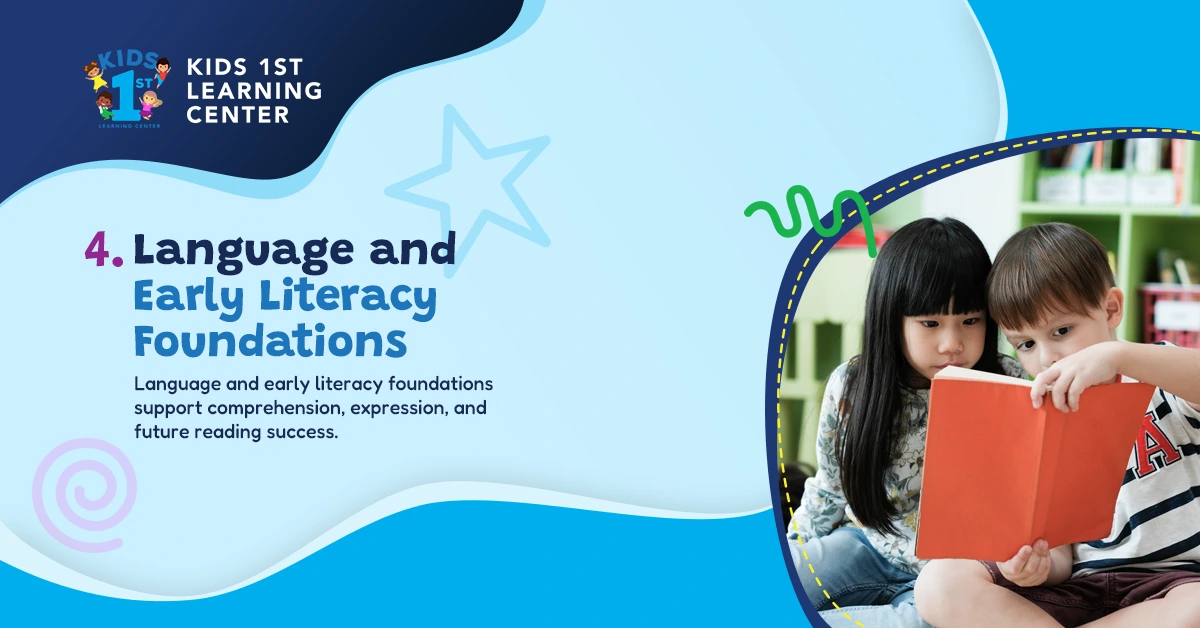
Language and early literacy foundations support comprehension, expression, and future reading success. Focus on strong oral language, phonological awareness, print concepts, and early writing so children can confidently participate in whole-group lessons and independent centers.
- Rich talk: Describe daily routines with precise words and expand on children’s statements to build vocabulary.
- Dialogic reading: Ask who/what/why questions, make predictions, and invite retells during shared books.
- Sound play: Practice rhyming, clapping syllables, and noticing the first sound in familiar words.
- Print concepts: Point left to right, track lines of text, and notice letters in names and classroom labels.
- Writing habits: Encourage name writing, drawing-and-labeling, and simple messages with invented spelling.
Short, frequent practice is most effective and can occur during meals, transitions, and outdoor play. Use labels, schedules, and environmental print to connect spoken and written language. Monitor progress with quick checks such as name recognition, rhyme production, and letter awareness, and share notes so home and school reinforce the same strategies.
Early Math and Number Sense
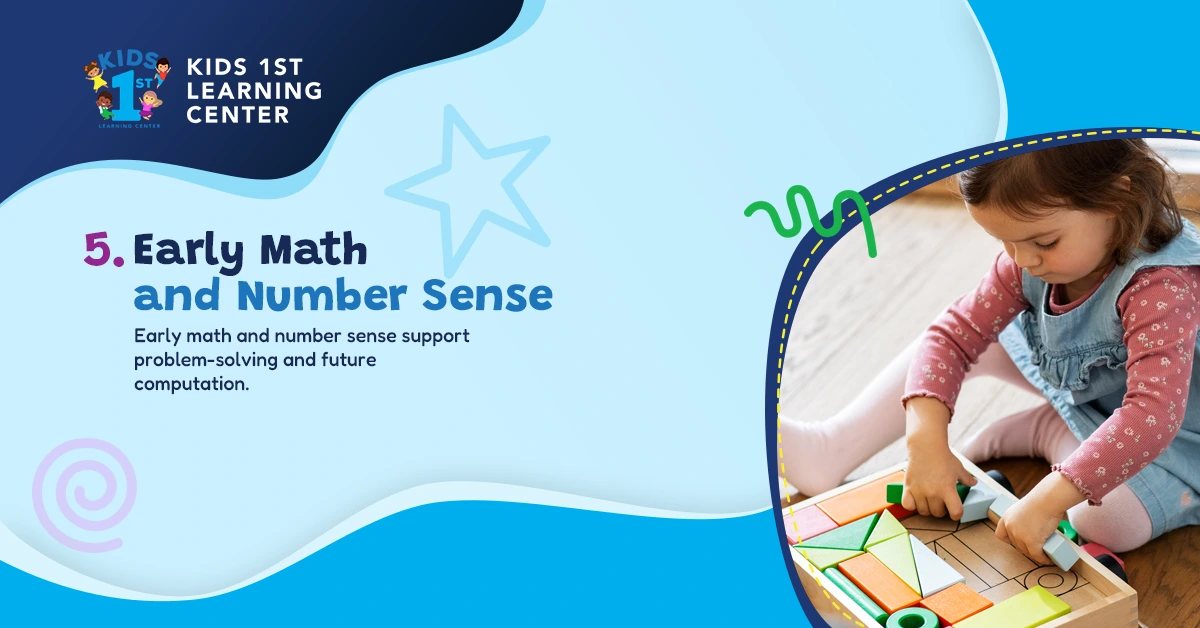
Early math and number sense support problem-solving and future computation. Instruction should emphasize concrete experiences, language-rich discussion, and visual models so ideas become meaningful and transferable. Short practice woven into daily routines builds confidence and accuracy over time.
- Counting with purpose: Count objects in stable order and connect the last number to the total.
- One-to-one correspondence: Touch or move each item once to avoid skips or repeats while counting.
- Comparisons: Use more, fewer, and same to compare quantities, lengths, and sets in context.
- Patterns: Build, extend, and describe repeating or growing patterns with blocks, beads, or motions.
- Shapes and spatial language: Name basic shapes and use in, on, under, and beside to describe position.
Embed math talk during snacks, cleanup, and outdoor play to link concepts with real experiences. Monitor progress with quick checks such as counting sets to 10, matching numerals to quantities, and explaining how a comparison was made, then adjust practice to strengthen understanding.
6. Fine Motor Control and Pre-Writing Readiness
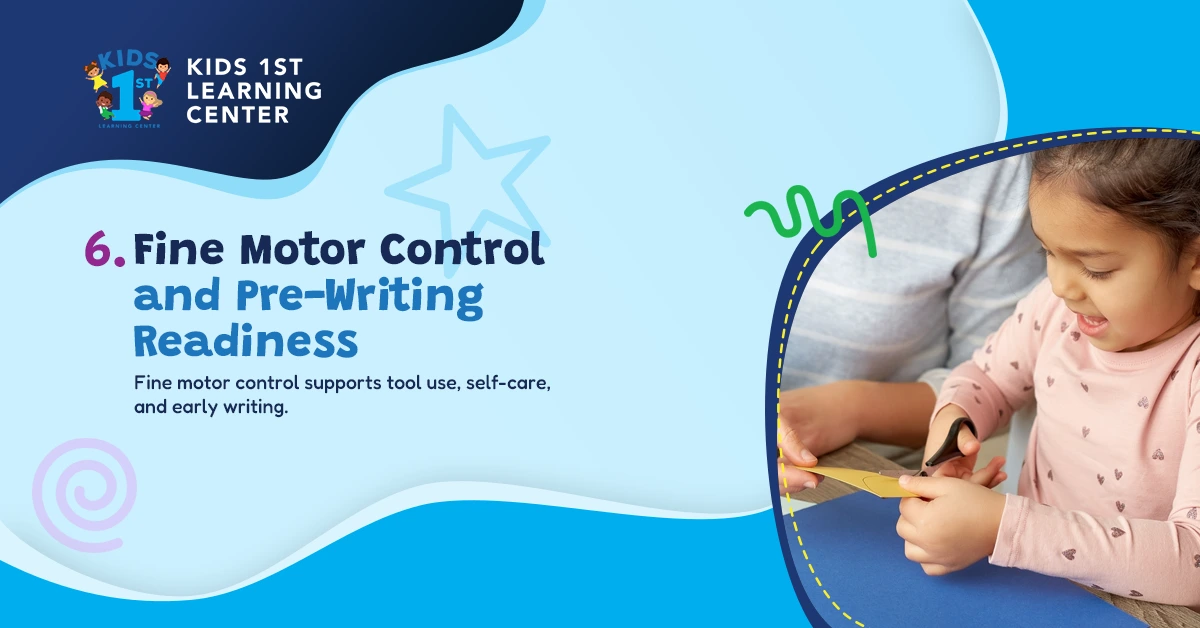
Fine motor control supports tool use, self-care, and early writing. Instruction should build hand strength, dexterity, and bilateral coordination through purposeful play and real-life tasks. Consistent routines help children develop efficient grasps and controlled strokes.
- Hand strength: Squeeze clay, tongs, and spray bottles to build endurance.
- In-hand manipulation: Roll, shift, and rotate small objects using fingers only.
- Pencil grasp: Practice tripod grasp with short crayons, mini markers, or golf pencils.
- Pre-writing strokes: Trace lines, curves, crosses, and simple shapes with steady pressure.
- Scissor skills: Snip, cut on thick lines, and turn paper with the helper hand.
Embed tasks into play centers and daily jobs such as peeling stickers, buttoning, and opening containers. Monitor comfort and control rather than speed, and adjust task size and tool choice to ensure successful, pain-free practice. Use vertical surfaces like easels or wall-mounted worksheets to encourage proper posture and wrist stability.
7. Gross Motor Coordination and Physical Confidence
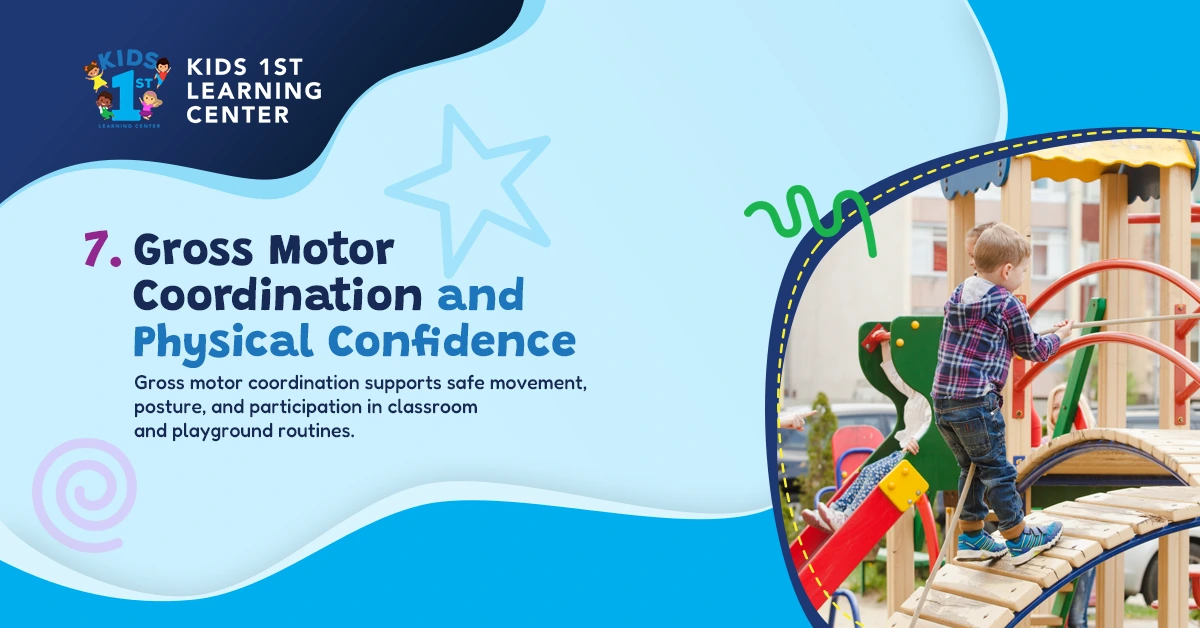
Gross motor coordination supports safe movement, posture, and participation in classroom and playground routines. Practice should build core strength, balance, and controlled locomotion so children can confidently line up, navigate spaces, and engage in group games.
- Core stability: Hold simple poses, crawl, and perform animal walks to support upright sitting and endurance.
- Balance: Stand on one foot, walk heel-to-toe, and step over low obstacles without rushing.
- Locomotor skills: Run, hop, gallop, and skip along marked paths, starting slowly and increasing distance.
- Ball control: Toss, catch, and kick with soft balls, focusing on eye tracking and two-hand readiness.
- Spatial awareness: Move around cones and peers while maintaining safe distances and controlled speed.
Integrate short movement circuits indoors or outdoors and alternate effort with brief rest. Use clear start–stop signals and visual markers to structure tasks and reduce collisions. Monitor progress by noting posture quality, number of consecutive repetitions, and ability to follow movement cues, then adjust challenge levels to maintain success and safety.
8. Self-Care and Personal Independence
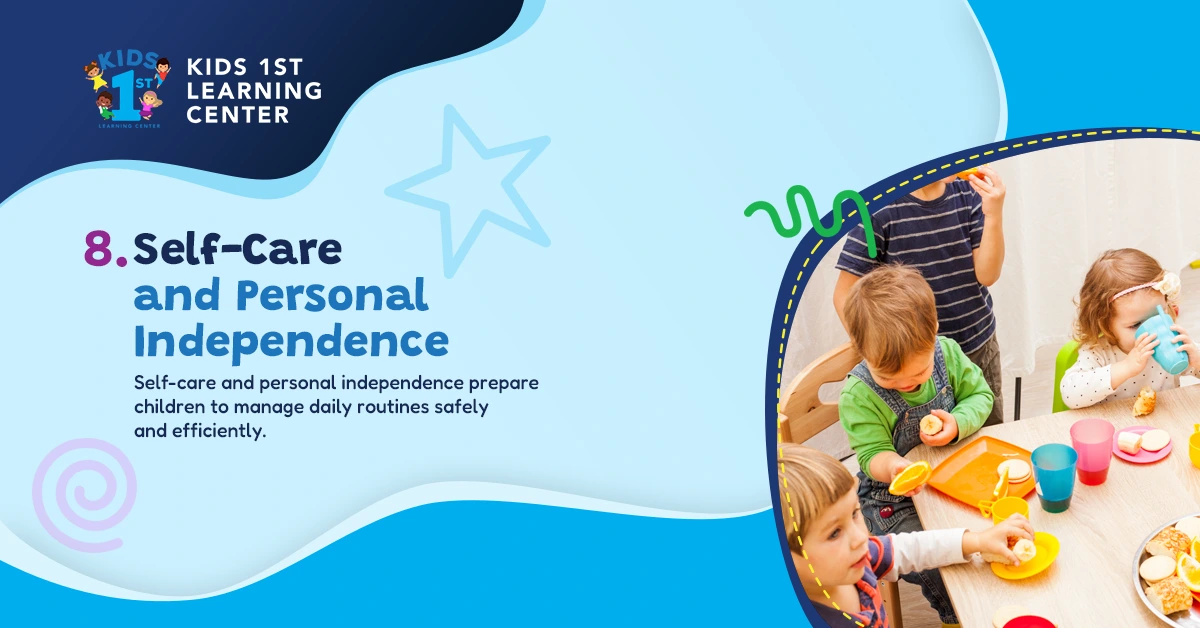
Self-care and personal independence prepare children to manage daily routines safely and efficiently. Consistent practice builds confidence, reduces transition time, and allows children to focus on learning when the day begins.
- Toileting and hygiene: Use the bathroom independently, wipe effectively, and wash hands with soap and water.
- Dressing skills: Manage zippers, snaps, and Velcro; put on and take off coats, shoes, and backpacks.
- Food management: Open everyday lunch items, use utensils, and tidy the eating space after meals.
- Belongings care: Keep a folder, water bottle, and personal items organized and return them to the correct place.
- Routine follow-through: Start and finish simple self-care tasks after a single prompt or visual cue.
Introduce these tasks during calm times and teach each step explicitly before expecting independence.
Use picture sequences, consistent language, and brief checklists to reinforce expectations at home and school. Track progress by noting which secure steps require prompts, then adjust supports to promote steady, reliable independence.
9. Classroom Routines and Executive Functioning
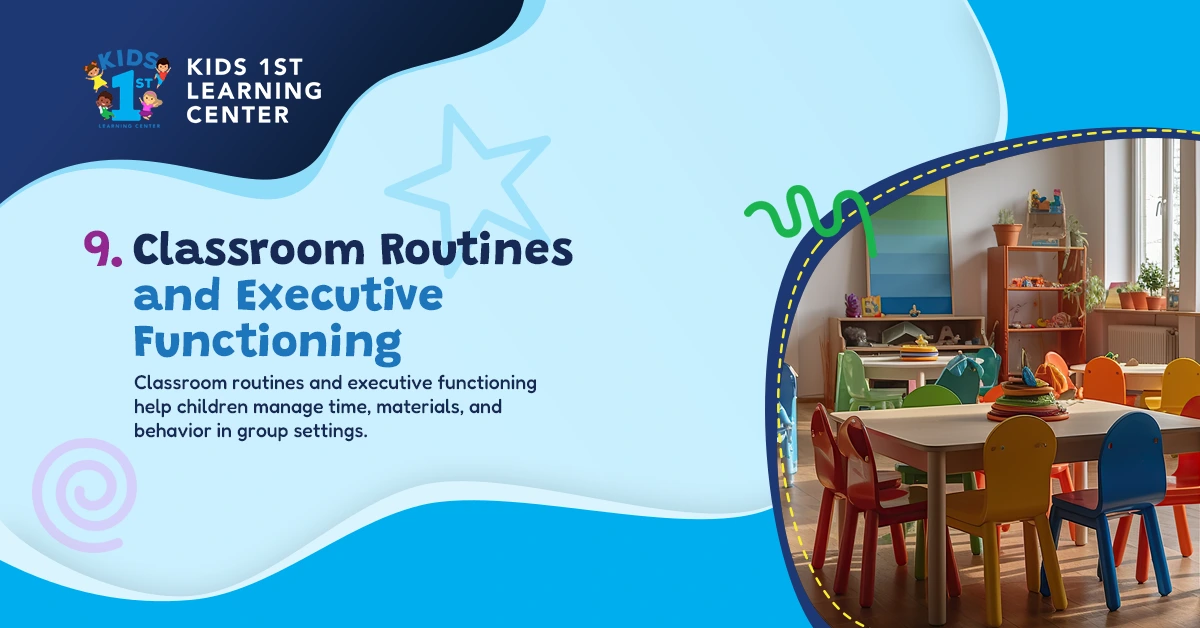
Classroom routines and executive functioning help children manage time, materials, and behavior in group settings. Instruction should emphasize predictable steps, clear cues, and brief practice that builds independence.
- Following schedules: Use a simple picture schedule and preview the next step before transitions.
- Start and finish: Begin tasks after a single prompt and complete them before switching activities.
- Materials management: Gather needed items, use them responsibly, and return them to labeled places.
- Working memory: Remember two-step directions and a rule while completing a task.
- Self-control and flexibility: Wait for a turn, pause before responding, and accept small plan changes.
Teach each routine explicitly, model the steps, and practice during calm periods rather than only when problems occur. Use timers, quiet signals, and short checklists to reduce uncertainty and support independent follow-through. Monitor progress by noting the number of prompts required and which steps are completed independently, then adjust supports to keep expectations clear and attainable.
10. Health, Safety, and Wellbeing Basics
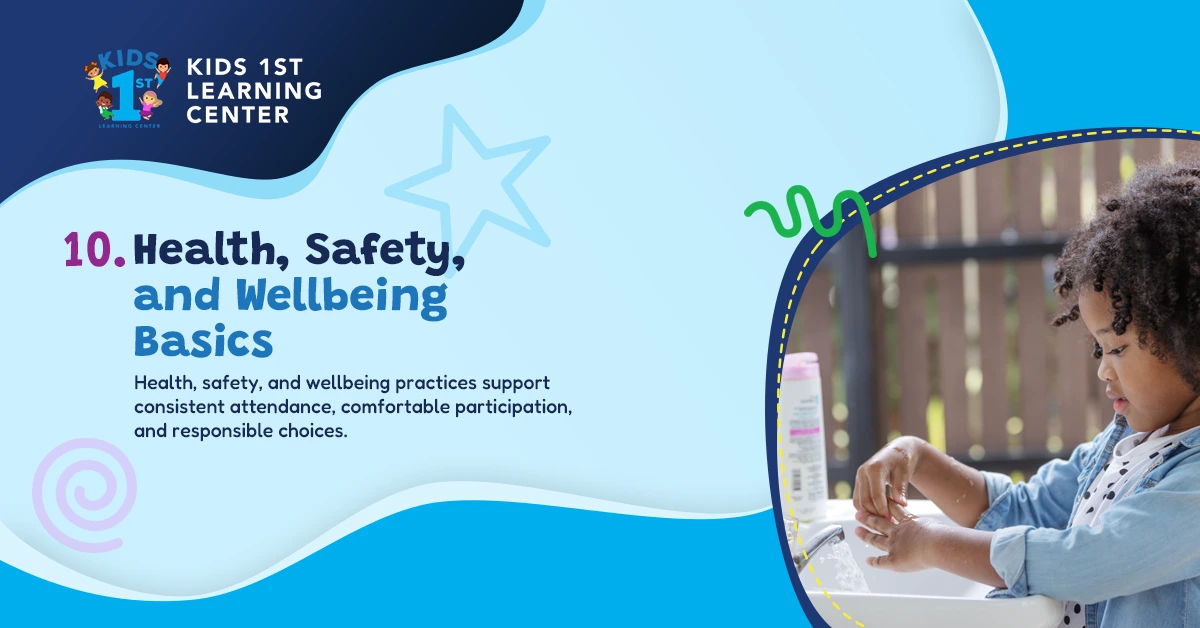
Health, safety, and wellbeing practices support consistent attendance, comfortable participation, and responsible choices. Children benefit from clear routines and shared language about staying healthy and safe at school and outdoors.
- Trusted adults and signals: Identify teacher and staff, follow safety signals, and seek help when unsure.
- Hygiene habits: Wash hands with soap, cover coughs and sneezes, and keep personal items to oneself.
- Safe materials use: Carry scissors safely, use supplies as intended, and follow rules for classroom tools.
- Body boundaries: Respect personal space, use consent language for touch, and report concerns to an adult.
- Health awareness: Tell an adult when feeling unwell, drink water regularly, and rest when needed.
Families can reinforce these habits with role-play, picture cues, and brief practice during daily routines. Share allergy, medication, or care plans with the school and review procedures for arrival, dismissal, and emergencies so expectations remain consistent.
Conclusion
A thoughtful kindergarten readiness checklist turns everyday routines into meaningful practice. When families and educators align language, expectations, and support tools, children arrive confident, calm, and eager to participate. Social–emotional growth, listening and direction-following, early language and math, motor development, self-care, and classroom routines are strengthened through short, consistent activities matching each child’s pace. Observation notes guide timely adjustments, while coordinated transitions ensure successful strategies continue from preschool to kindergarten.
For personalized guidance or to plan next steps, contact Kids 1st at (818) 873-0133 or visit https://kids1st.org/contact-kids-1st/.

